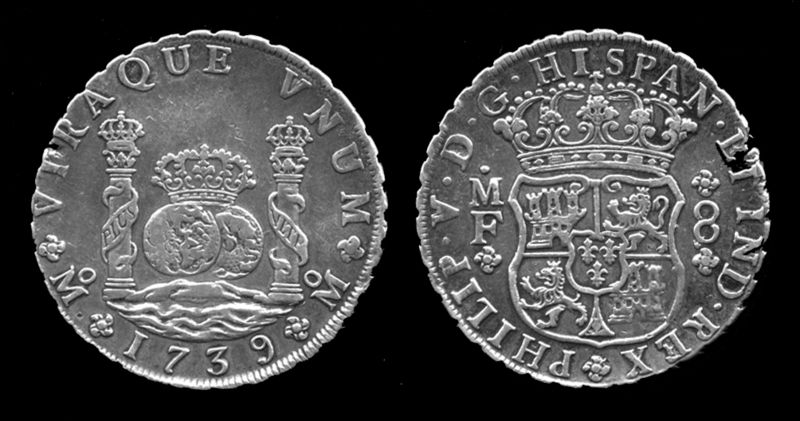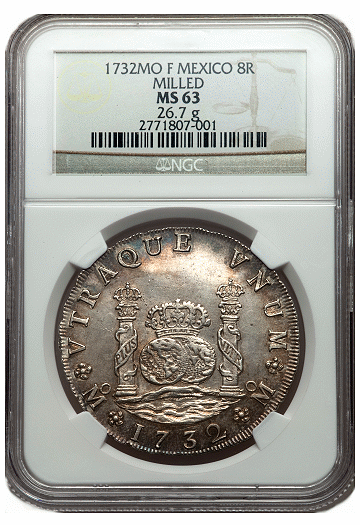Historic 'Silver Dollar' Sets Auction Record
During the formative decades of the United States' history, hard currency was very hard to come by. You were often forced to turn to foreign coins just to conduct commerce.
British Empire legal tender was in short supply in part because Britain deprived her colonies across the Atlantic of coins, especially small denominations, to keep them economically dependent. As a result, Spanish 8 Reales silver coins minted elsewhere in the Americas—Bolivia, Chile, Colombia, Guatemala, Mexico, Peru—became the the preferred specie currency of the United States both before and for a time after its independence from Great Britain.
You could argue the Spanish milled dollar was the de facto currency standard of the colonies and early republic.¹

History of the 8 Reales in America
Believe it or not, the Founding Father and third U.S. president, Thomas Jefferson, proposed setting the value of the U.S. dollar (as defined by law) to match the silver weight of its Spanish counterpart. This shows how integral it was to American business and trade. Also known as the Spanish milled dollar or pillar dollar, the Mexico 8 Reales coin is widely considered "America's first milled 'silver dollar'" by American numismatists. It is also the first standard silver coin minted in the New World, issued beginning in 1598 by the Spanish Empire.
It may be surprising to find that this coin was indispensable in supporting commerce in the colonies. In fact, foreign currency was widely used in the U.S. during the late 18th and early 19th centuries. This was true even after the U.S. Mint began producing its own coins in 1792. Spanish silver dollars were officially accepted as U.S. legal tender until the end of the 1850s.
Have you ever heard the uniquely American expression "two bits" to mean roughly 25 cents? This concept came from the idea that 8 Reales—real de a ocho or peso de ocho—were known as "pieces of eight," and crudely cut portions of the Spanish-American milled dollar functioned as fractional currency around the country.
Record-Setting Auction
 Image courtesy of Heritage Auctions via CoinWeek
Image courtesy of Heritage Auctions via CoinWeekOne of these historic coins, a 1732 Spanish milled dollar minted in Mexico City, was sold during the world coins and ancient coins auctions hosted by Heritage Auctions at the ANA World's Fair of Money last week. It realized $152,750, the most ever for a pillar dollar of its type at auction.² The final auction price was more than double what comparable specimens typically garner.
Recent shipwreck finds in the Atlantic Ocean have brought some new examples of this classic coin to market, but most are in very worn condition. This specimen (pictured, right) was graded an impressive Mint State 63 by Numismatic Guaranty Corporation (NGC). Its exceptional level of preservation makes it easy to forget that this coin is actually 284 years old!
References
- Yeoman, R.S. (2012). The Spanish Milled Dollar. A Guide Book of United States Coins (Official Red Book), 65, 10-11. Bressett, Kenneth, & Bowers, Q. David, & Garrett, Jeff (Eds.). Atlanta, GA: Whitman.
- Heritage Auctions (2016, August 13). World Coins—New Record Set for America's First Milled "Silver Dollar." CoinWeek. Retrieved from http://www.coinweek.com/auctions-news/world-coins-new-record-set-americas-first-milled-silver-dollar/
The opinions and forecasts herein are provided solely for informational purposes, and should not be used or construed as an offer, solicitation, or recommendation to buy or sell any product.

Everett Millman
Everett has been the head content writer and market analyst at Gainesville Coins since 2013. He has a background in History and is deeply interested in how gold and silver have historically fit into the financial system.
In addition to blogging, Everett's work has been featured in Reuters, CNN Business, Bloomberg Radio, TD Ameritrade Network, CoinWeek, and has been referenced by the Washington Post.
